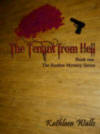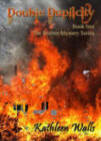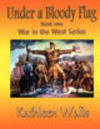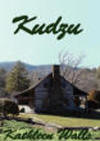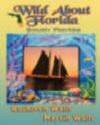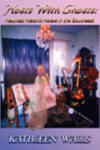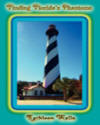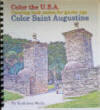Colonial Williamsburg Where Past and
Present Meet
by Kathleen Walls
Williamsburg is one
of those magic places where history is ever present.
Williamsburg was founded between 1630 and 1633 when some
Jamestown settlers moved there. Jamestown's capital building
burned twice, the second time In 1698. The locals in Jamestown
were tired of the unhealthy climagte and decided to permanently
move the capital Williamsburg. The once small community grew
and prospered until a later governor, Thomas Jefferson, moved
the capital to Richmond. Williamsburg retuned to its early
small village status.
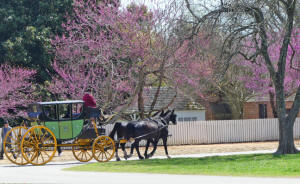
The 20th
century growth in tourism led to rebirth. Today, Colonial
Williamsburg is Virginia's most popular destination for
travelers. Here on the 17th century style streets
and preserved or recreated buildings, you can you meet famous
characters from history. I met the Marquis de Lafayette. Both a
young General George Washington and a later President
Washington roams Williamsburg streets along with many other
famous figures of the 17th century.
Colonial Williamsburg is very walkable, but you can safe
the feet with the free
shuttle that runs every 15 minutes from 9AM until 10PM with
eight stops around the district.
Capitol
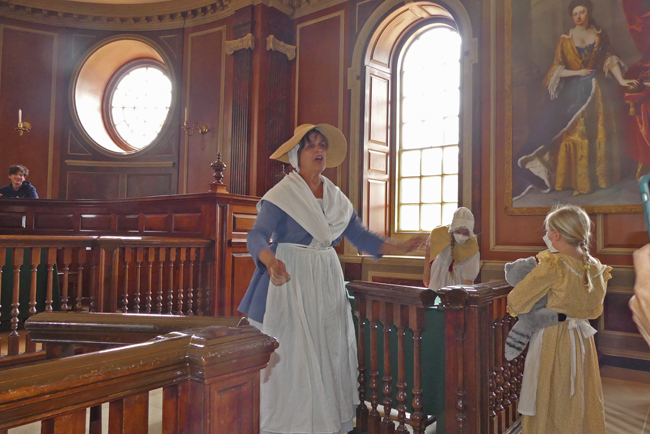
The most impressive
building in Williamsburg is The
Capital. It's not original but an authentic recreation of
the first capital built in 1705 built in a Georgian style with
twin apses, curved turret-like buildings, with a joining middle
section.
Our guide led us
through the Capital beginning in the section used as a
courtroom and took us through the general assembly sections.
She enlivened her demonstrations by letting us act at
participants in the activities carried on in each section. We
caw how early Virginia laws were introduced and passed. I
learned that Virginians declared independence on June 29, 1776
from Great Britain and wrote Virginia's first constitution four
days before Congress voted for the Declaration of Independence.
The most interesting
event was
Cry Witch at the Capital held at night. We attended a mock
trial of Grace Sherwood, the so-called Witch of Pungo. The
actors portraying the judge, district attorney, Grace, and
witnesses were so talented. During the trial, the judge called
on the audience to ask questions, and after they heard the
witnesses, he allowed us to vote. Grace was found guilty by a
42 to 40 vote.
Governor's Palace
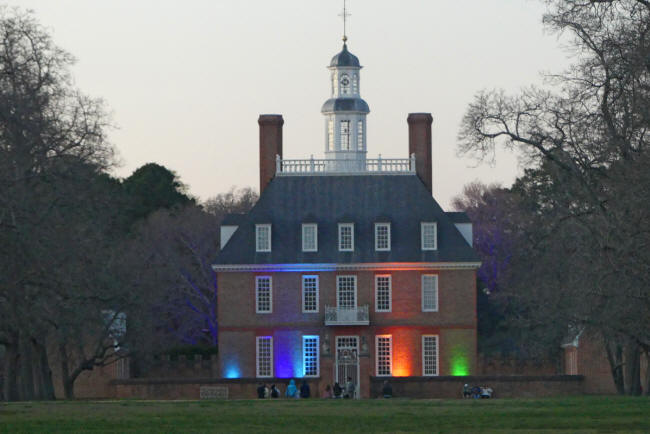
The
Governor's Palace sits opposite the Capital at the end of
Palace Green, a lovely green space It's a replica of the
burned-down original mansion. There's a magnicificent gardens
and outbuilding to self-toured. The Palace tour has
a docent who took us
through the building. When t was the home of the governor, not
many people got past the entry hall and adjourning offices. The
privileged few who were invited to the balls danced until dawn.
Randolph House
and Yard

The dark-red frame
Peyton
Randolph House is one of the oldest houses in Colonial
Williamsburg. Built in 1715, it was the home of Peyton
Randolph, President of the First and Second Continental
Congresses, and his wife, Elizabeth. It served as a hospital to
treat wounded soldiers during the Revolution and is reputtedly
the most haunted house in the US.

The
Randolph Yard tells the story of the enslaved people here.
The docent in the kitchen talks about Betty, the head cook at
the Randolph house. Betty presided over the largest domestic
kitchen in Williamsburg, some 2,000 square feet. She had
several assistants. Messy work would get done in a separate
room in the kitchen complex, not where Betty cooked. She cooked
only for the Randolph family and guests, not the other enslaved
people. According to records from Mr. Randolph's death, they
valued Betty at 100 pounds.
A docent led us
around from the Randolph house to other parts of the village.
She told the story of how slavery came to Williamsburg.
Although Peyton Randolph, his cousin, Thomas Jefferson, George
Washington, Patrick Henry, and others demanded freedom from
Great Britain, they didn't seem to recognize the paradox of
enslaving other people.
In the early 1600s,
England offered people in prison an option. "You can serve your
time here in prison, or we will let you go to Virginia and
serve as an indentured servant for a period of a few years and
then you will be free." Poor people, mostly Irish then, were
told they could come to the colonies and, after their indenture
term, get their own land and live better. These people came to
Virginia.
Meantime, In
Virginia, the gentry learned from the Indians did well growing
tobacco. Colonists put the indentured servant to work in the
tobacco fields and soon found out these people, often very fair
skinned, didn't hold up well in the blistering sun.
Then they discovered
African indentured servants who knew how to work in fields and
grow things. By the late 1600s, there were between 3,000 to
6,000 enslaved people; by the 1700s, there were 60,000. Tobacco
was a hard crop. After you grew it for a few years, you had to
abandon those fields for about 10 years. Since the more they
grew, the more land the king gave them, they didn't care. The
more land they had, the more servants they needed. Greed
insured they didn't want to let the indentured servants go
after the term ended, so they created a devilishly clever law
making servitude permanent.
In 1682, Virginia's
General Assembly passed the so called "Slave Code" that existed
until the Civil War. The code decreed that "all non-Christian
servants entering the colony are to be slaves." Just because a
Black person got baptized, they were slaves since they had not
been baptized when they entered the country. The code also
changed the English law to inheritance through the maternal
side, so if a slave woman had a child, it inherited the
mother's slave status.
Archaeology Sites
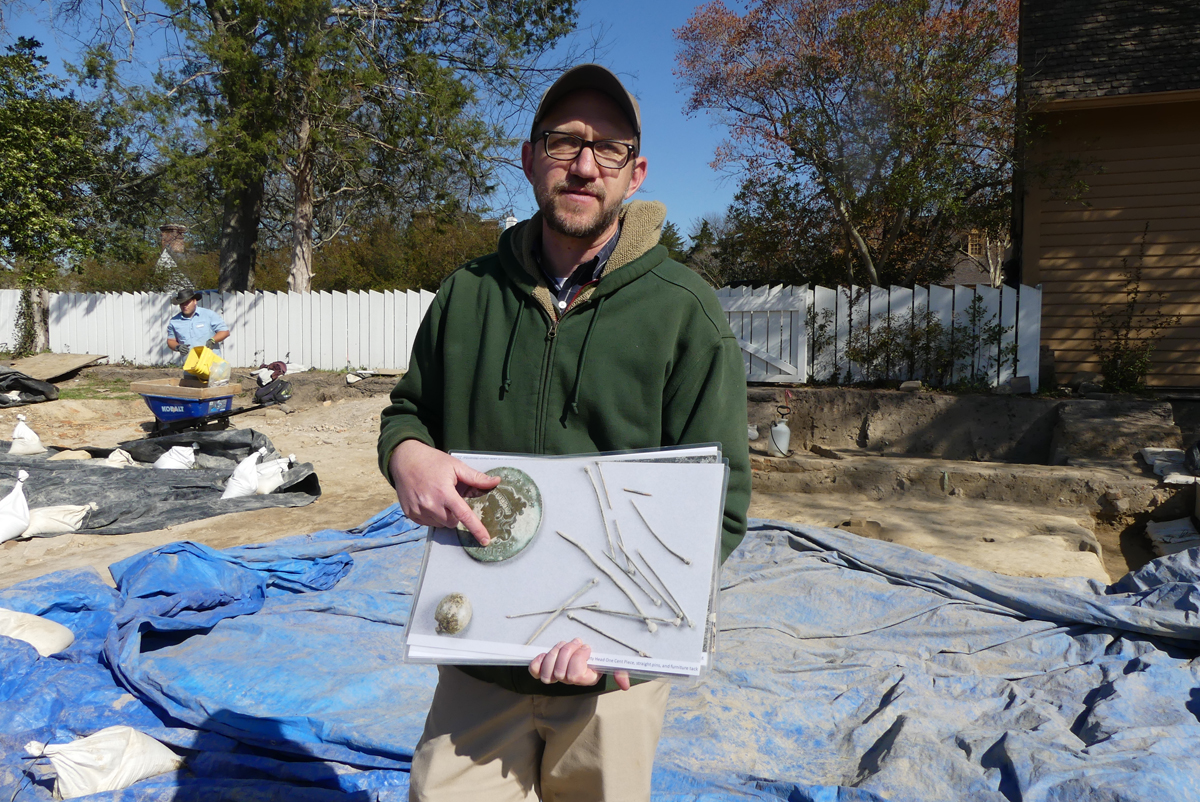
Williamsburg today
is trying to show all of history Black and white. It prides
itself on being historically accurate.
One important site they're excavating now is the site of two
African American Baptist Churches. The mid-19th century
First Baptist Church
was torn down, as it portrayed a later time. Now they are
excavating an earlier smaller building beneath the ruins of the
later church. The site shows the earlier one was constructed in
the mid-1700s, making it one of the oldest African American
churches in the country.
There are exhibit
telling the church history in the Taliaferro Cole Stable across
the street from the excavation site.
Custis Square, catty-corner from the church site, is
another archaeological site where John Custis IV's home and
gardens were. Custis was the father of Martha Washington's
first husband, Daniel Custis.
Tradesmen

Throughout the
Historic
District, there are the places where various tradesmen
worked. I visited several. The tailor and his journeyman showed
how they made clothes for the local people. The blacksmith shop
was had several smiths toiling at the forges. There are
tinsmiths, builders, apothecaries, hatmakers, cabinet makers,
wigmakers, and more.
Public Gaol

This old jail was
where debtors and criminals were
imprisoned. Some of Blackbeard's pirates were held here
before being hanging.
Bruton Parish
Church

This was the
official Episcopal church, and they expected all Virginians
to attend regularly. It is still an active church. There is a
small museum and gift shop on the same block that tells church
history.
Historic Gardens

Throughout the
district, there are several
historic gardens with docents to tell about the crops grown
then. We saw many of the farm animals, including sheep and
horses, that pull the historic carriages you can book to tour
the village.
Haunted
Williamsburg Ghost Tour

You can walk around
the historic district free but you need to purchase a ticket
for entry into the buildings. Additional tours are available to
purchase. One tour we took was the
ghost tour.
It was
fascinating and Iris, our guide, told stories about the places
in the district, including personal experiences and encounters
by her and other staff members.
Merchants Square

Just outside the
historic district, there are other places you want to visit.
Merchants Square at
the end of the Historic District offers modern shops, dining,
and Kimball Theater.
Art Museums

The
Art Museums have multiple galleries with art ranging from
folk art to objects from Colonial Williamsburg. Some
collections are "A Gift to the Nation," "Navajo Weavings:
Adapting Tradition," "Art of the Quilter," and "American Folk
Pottery."
Golden Horseshoe
Golf Club

I'm not a golfer but
even if you aren't, the
courses here are worth a look. They were designed by the
father-and-son team of Robert Trent Jones Sr. and Rees Jones.
We took a golf cart tour of the course, and the beauty of the
course is impressive.
Spa
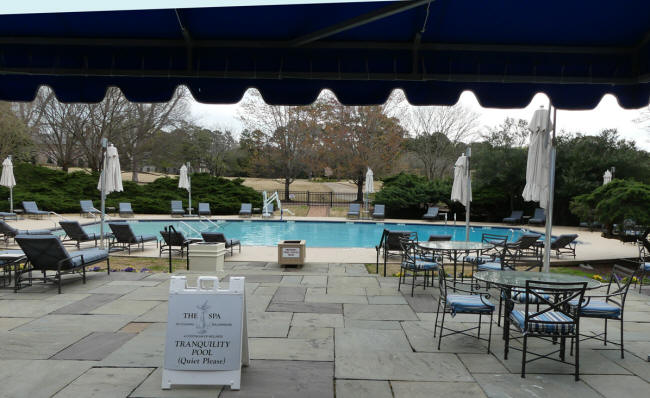
The
Spa
of Colonial Williamsburg is a treat to soothe the mind and
body. Besides the traditional spa facilities, shower, steam
rooms, and whirlpools, they have hair and nail salons, a
well-equipped fitness center, indoor pool, family pool, and
tranquility pool.
For dining you have
many great choices. Here are a few.
Kings Arms Tavern

Jane Vobe opened the
original
tavern in 1772 and today's authentic reproduction serves
the food of the 18th century tailored to meet
modern-day tastes. The décor is authentic, and the servers are
dressed in period costume. John, our server, gave us detailed
stories about the food and culture. Peanut Soupe––spelling on
the menu is true to the times––was a popular item. I had the
Smoked Golden Yard Bird for my entrée. Superb! John told us
people of that time ate dessert to clean the palate, so I had
no guilt over my pecan pie with butter pecan ice cream.
Terrace Room

The
Terrace Room, in the Williamsburg Inn where Queen Elizabeth
II stayed when she visited Williamsburg, is another fabulous
choice. I recommend the shrimp cocktail and had the maple
mustard glazed Duroc pork tenderloin entrée. For dessert try
bananas Foster crème brûlée. The food and atmosphere really are
fit for royalty.
Sweet Tea and
Barley
Sweet Tea and Barley in Williamsburg Lodge where we stayed
is a cozy place with the 18th century feel. I
started with Chesapeake crab chowder, then had shrimp and grits
for my entrée. The spiced bread pudding with vanilla ice cream
for dessert is a perfect finish.
Lodging

Williamsburg Lodge is just a short way from
the Historic District.
It has several guest houses. There's a shuttle stop in front. I
stayed in the Ashby Guest House with all the modern amenities
set in a 17th style.

















